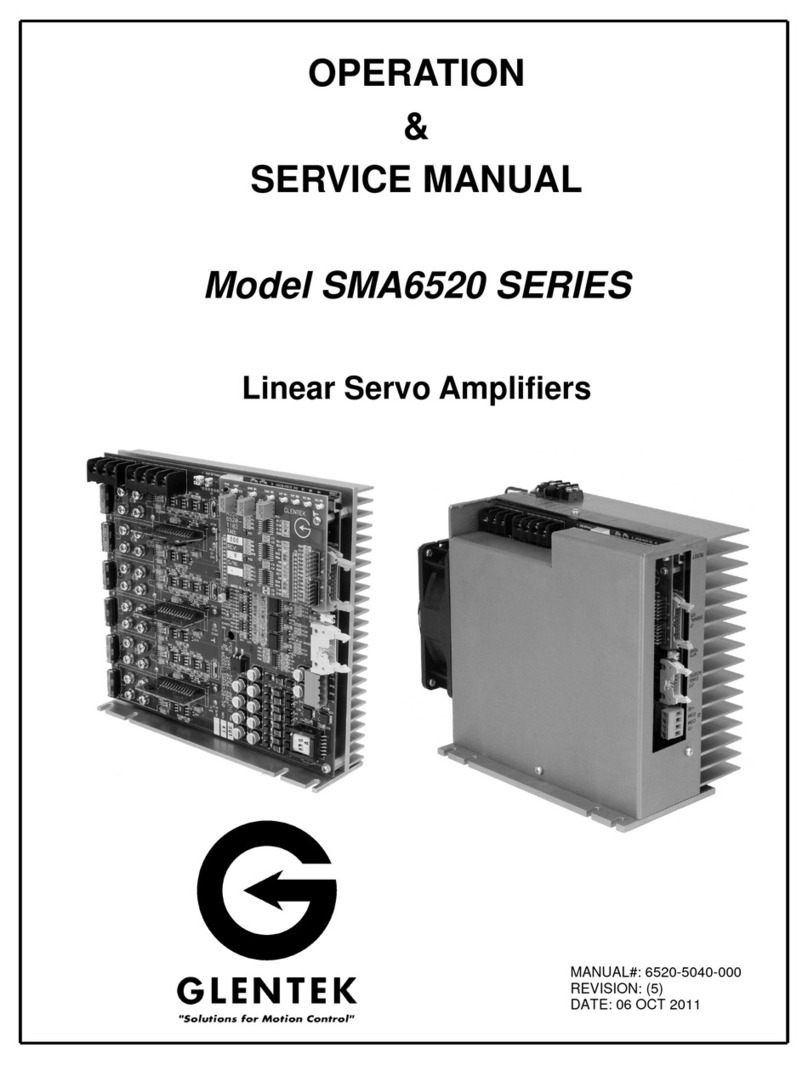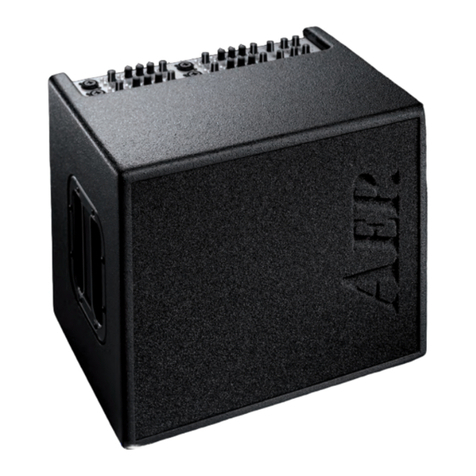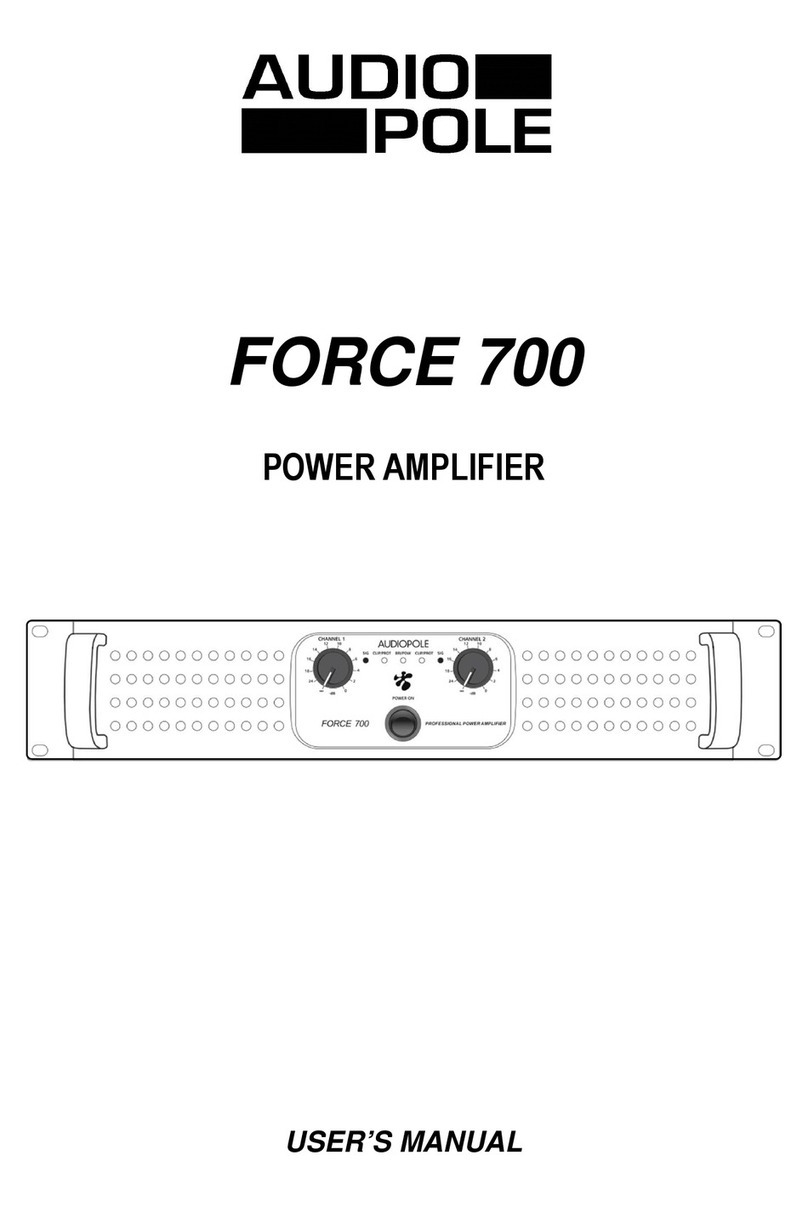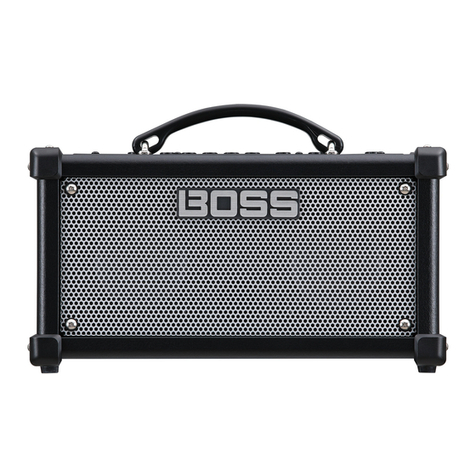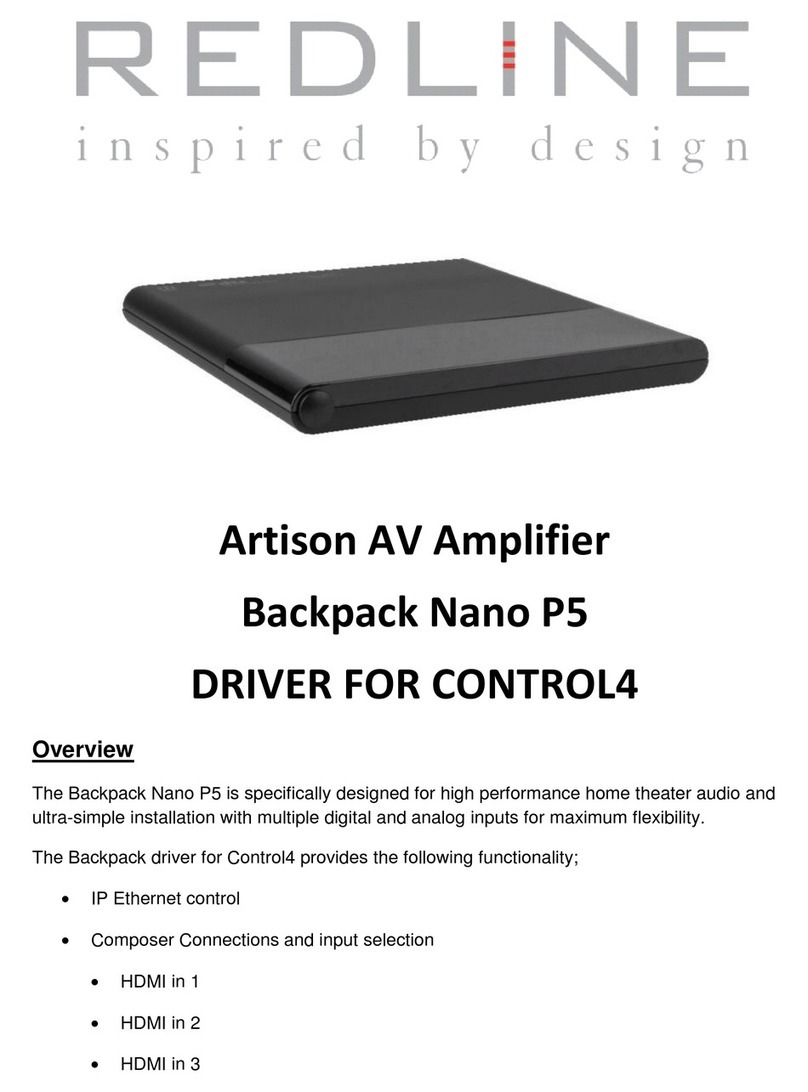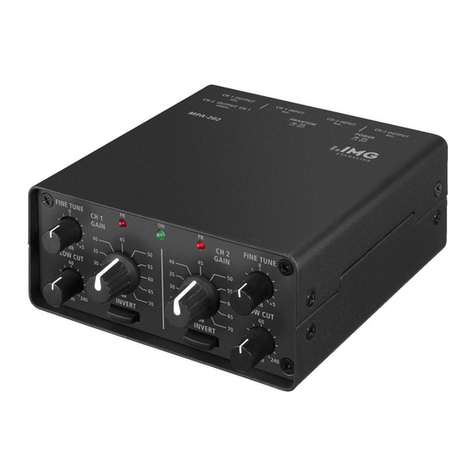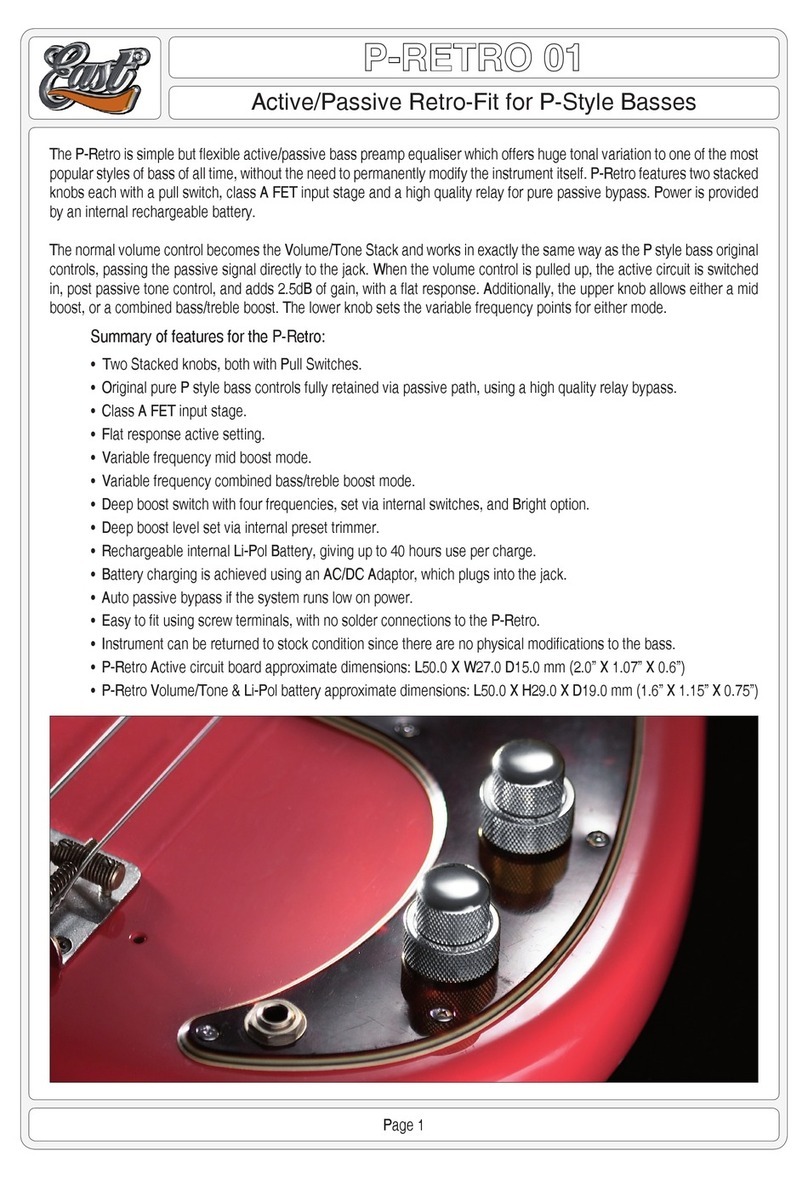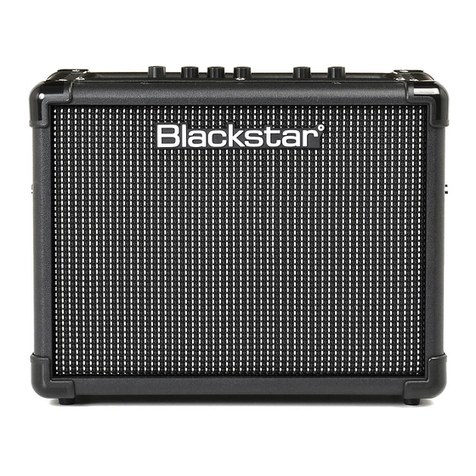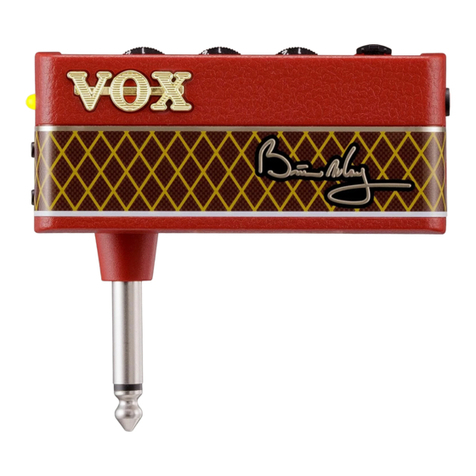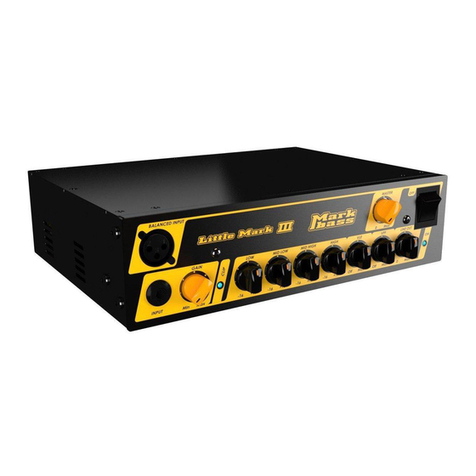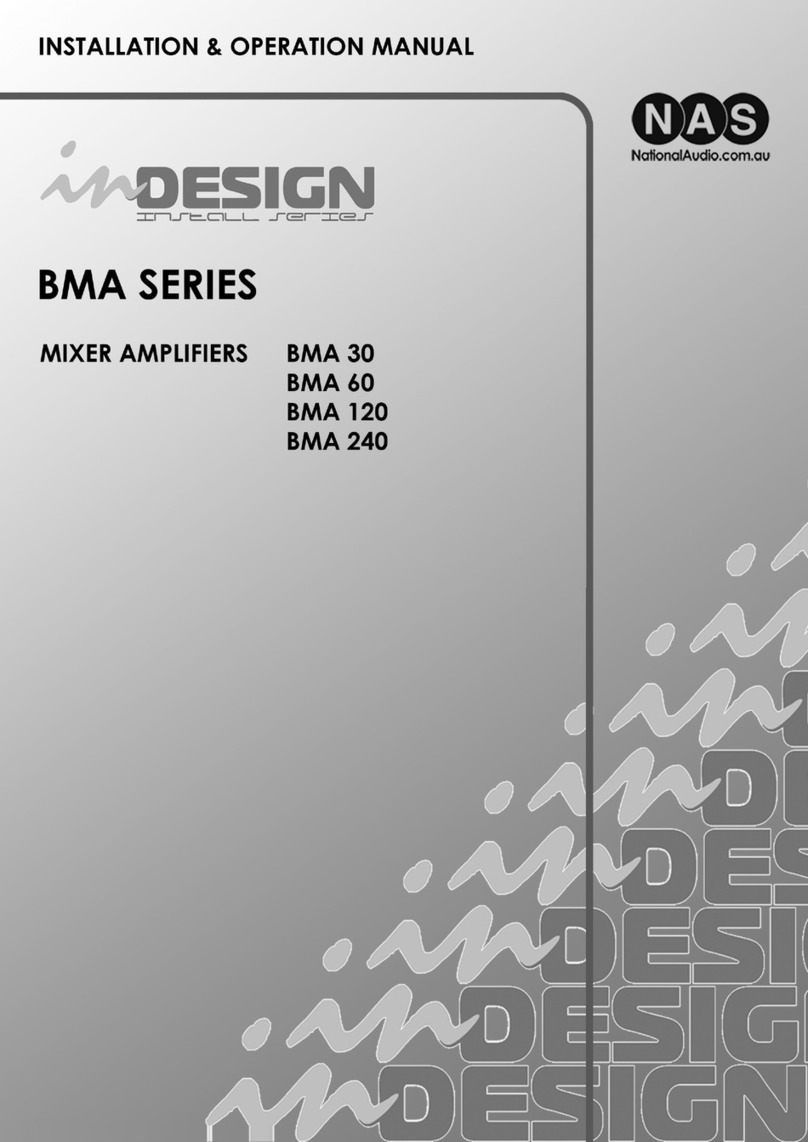Glentek Omega Series User manual

INSTALLATION
&
OPERATION MANUAL
Omega Series
Model SMA9807
Model SMA9815
Model SMA9830
Digital PWM Brushless Servo Amplifiers


Glentek Inc. 208 Standard Street, El Segundo, California 90245, U.S.A. (310) 322-3026 3
TABLE OF CONTENTS
TABLE OF CONTENTS ........................................................................................ 3
OVERVIEW ........................................................................................................... 6
Product Description............................................................................................... 7
FULL FEATURE SERVO AMPLIFIER ...................................................................................7
2-PHASE CURRENT MODE SERVO AMPLIFIER...................................................................7
PULSE FOLLOWER SERVO AMPLIFIER ..............................................................................7
Quadrature...........................................................................................................8
Pulse (step) and Direction....................................................................................8
CW/CCW Pulse mode..........................................................................................8
Features ................................................................................................................ 9
Digital Amp Control Loop Diagram...................................................................... 11
Amplifier Setup Software..................................................................................... 12
MOTIONMAESTRO INSTALLATION ...................................................................................12
MOTIONMAESTRO AMPLIFIER SETUP FEATURES..............................................................13
Opening of communications...............................................................................13
Model Information ..............................................................................................14
Digital I/O setup..................................................................................................15
Amplifier mode setup..........................................................................................15
Motor Parameters ..............................................................................................16
Motor Safety.......................................................................................................16
Commutation setup............................................................................................17
Encoders............................................................................................................17
Trajectory Generator..........................................................................................18
Filters.................................................................................................................18
Oscilloscope.......................................................................................................18
Terminal Window ...............................................................................................20
Amplifier Status..................................................................................................20
Control Loop Signals..........................................................................................21
Digital Inputs ......................................................................................................21
Faults.................................................................................................................21
Warnings............................................................................................................21
Status.................................................................................................................22
Control Panel .....................................................................................................22
Motor Tuning......................................................................................................22
Saving parameters to non-volatile memory ........................................................23
Creating a back up copy of amplifier parameters on disk...................................23
HARDWARE ....................................................................................................... 24
STATUS DISPLAY ..........................................................................................................24
CONTROLLER INPUT AND OUTPUT SIGNALS....................................................................24
Command signal, Analog input...........................................................................25
Analog output.....................................................................................................26
Discrete Input.....................................................................................................26
Limits......................................................................................................27
Amplifier hardware inhibit .......................................................................27
Amplifier reset.........................................................................................27
Amplifier fault output...........................................................................................27
Encoder output...................................................................................................27

Glentek Inc. 208 Standard Street, El Segundo, California 90245, U.S.A. (310) 322-30264
Omega Series Digital PWM Amplifier Manual
External encoder power......................................................................................27
POWER INPUT AND OUTPUT SIGNALS.............................................................................27
Bus power..........................................................................................................28
Motor power.......................................................................................................28
PC INTERFACE .............................................................................................................28
OPTIONAL RELAY I/O....................................................................................................29
ENCODER FEEDBACK ....................................................................................................30
Encoder power, amplifier supplied......................................................................30
Encoder channels A, B and Z.............................................................................30
Hall channels 1, 2 and 3.....................................................................................30
External event fault.............................................................................................30
RESET .........................................................................................................................30
AMPLIFIER/MOTOR INTEGRATION ..................................................................................31
EXTERNAL WIRING OF THE AMPLIFIER.............................................................................31
Serial Port ..........................................................................................................31
Encoder Logic....................................................................................................31
Power.................................................................................................................31
APPLYING POWER TO THE LOGIC SECTION.....................................................................31
PARAMETER SETUP ......................................................................................................32
PHASING THE MOTOR....................................................................................................32
APPLYING POWER TO THE MOTOR.................................................................................33
VELOCITY TUNING ............................................................................................34
2-PHASE CURRENT MODE OPERATION TUNING PROCEDURE...........................................37
APPENDICES......................................................................................................38
A SERVO DRIVE CONNECTIONS ..................................................................................39
B COMMUNICATION ERROR CODES .............................................................................43
C AMPLIFIER STATUS CODES......................................................................................44
D GLENTEK SMA9800 SERIES AMPLIFIER COMMANDS ................................................45
E AMPLIFIER COMMANDS ............................................................................................46
F SMA9800 RATINGS AND SPECIFICATIONS................................................................47
Power, Input and Output.....................................................................................47
Signal Inputs ......................................................................................................47
Digital Inputs ......................................................................................................47
Outputs ..............................................................................................................48
System...............................................................................................................48
Notes..................................................................................................................48
G MATCHING MOTOR PHASE LEADS TO AMPLIFIER COMMANDS USING HALL SENSORS......49
H DETERMINING ENCODER RESOLUTION AND NUMBER OF POLES...................................54
I COMMUTATION TRACK SIGNALS AND PHASE-TO-PHASE BEMF. ..................................55
J EUROPEAN UNION EMC DIRECTIVES .......................................................................56
Electromagnetic Compatibility Guidelines For Machine Design..........................56
Declaration of Conformity...................................................................................62
K AMPLIFIER TERMS AND TECHNOLOGY ......................................................................63
Terms.................................................................................................................63
Technology.........................................................................................................66
L AMPLIFIER MODEL NUMBERING ...............................................................................67
SMA9807 Amplifier Model Numbering................................................................68
SMA9815 Amplifier Model Numbering................................................................71
SMA9830 Amplifier Model Numbering................................................................74
M FACTORY REPAIR & WARRANTY .............................................................................76
N DRAWINGS .............................................................................................................78
SMA9807-1 Amplifier module....................................................................79

Glentek Inc. 208 Standard Street, El Segundo, California 90245, U.S.A. (310) 322-3026 5
SMA9807-1A-1 Stand alone amplifier............................................................ 80
SMA9807-2A-2 2 axis base plate chassis installation....................................81
SMA9807-4A-4 4 axis Installation.................................................................. 82
SMA9815-1 Amplifier module.................................................................. 83
SMA9815-1A-1 Stand alone amplifier............................................................ 85
SMA9815-2A-2 2 axis base plate chassis installation....................................86
SMA9815-4A-4 4 axis base plate chassis installation.................................... 87
SMA9830-1A-1 Amplifier .............................................................................. 88
Table of Contennts

Glentek Inc. 208 Standard Street, El Segundo, California 90245, U.S.A. (310) 322-30266
Omega Series Digital PWM Amplifier Manual
Overview
This manual guides the application engineer through the steps necessary for a successful installation
of an application using the Omega series amplifiers. All features of the digital amplifier are explained
and all necessary procedures for installation and tuning are covered. The following sections are pre-
sented in the order that would make installation easiest for most first time users of the amplifier.
The “Product Description” and “Features” sections contain information for the application engineer to
determine if the Omega series amplifiers are appropriate for his application.
Next MotionMaestro©software is introduced. Enough material is given here to familiarize the applica-
tion engineer with the tools necessary to setup and tune a motor using the Omega series amplifiers.
The hardware section outlines the hardware and connectors necessary to install a Omega series am-
plifier into an application.
Once these preliminaries are out of the way, the application engineer is brought through a step by step
procedure that accomplishes system setup. In System Setup, the steps necessary to bring up and ver-
ify a fully functioning amplifier/motor combination is reviewed.
Finally, Tuning is covered where the application engineer can use MotionMaestro©to fine-tune the digi-
tal current or velocity loop to meet the specific demands of the application.

Glentek Inc. 208 Standard Street, El Segundo, California 90245, U.S.A. (310) 322-3026 7
Product Description
Glentek’s Omega Series Digital PWM Brushless Servo Amplifiers offer the latest in high performance
DSP control of both rotary and linear brushless servo motors. With extensive utilization of surface
mount technology and special heat transfer techniques, the Omega Series offers one of the world’s
most powerful products for a given form factor. The Omega Series is comprised of the following mod-
els:
Full Feature Servo Amplifier
The Full Feature servo amplifier operates in current (torque) mode or velocity (RPM) mode, accepts a
+/-10V analog input as a command reference and commutates the motor sinusoidally for ultra smooth
operation at low speeds. The amplifier utilizes an incremental encoder to derive the velocity signal and
to commutate the motor. The absolute commutation angle is usually determined using Hall sensors or
encoder Commutation tracks. However, in some cost sensitive applications where slight motor move-
ment is acceptable upon power up, the amplifier can perform a power-on phase finding algorithm which
eliminates the need for Hall sensors or Commutation tracks. Special versions are also available that
decode Sanyo Denki, Tamagawa and Yaskawa reduced wire encoders.
2-Phase Current Mode Servo Amplifier
The 2-Phase Current Mode servo amplifier accepts two +/-10V analog inputs as current command ref-
erences for two of the motor phases. The third phase is derived from the two reference phases. This
model amplifier does not use any feedback devices and is used with controllers that provide the com-
mutation.

Glentek Inc. 208 Standard Street, El Segundo, California 90245, U.S.A. (310) 322-30268
Omega Series Digital PWM Amplifier Manual
Pulse Follower Servo Amplifier
The Pulse Follower servo amplifier incorporates all the features of the Full Feature servo amplifier and
also accepts two digital pulse inputs as a position command reference. The two pulse inputs are high
speed, differential and optically isolated digital inputs which can be configured to decode three pulse
types and can be geared up or down (electronic gearing). The motor position and speed are a function
of the number of pulses and the rate of the pulses respectively. The following pulse types can be de-
coded:
Quadrature
Two pulse inputs in quadrature, such as the output of an incremental encoder or an encoder pot
determine both command distance and direction. This pulse decoding is useful to slave one mo-
tor to another by connecting the master motor’s encoder output to the slave motor’s pulse inputs.
Pulse (step) and Direction
The first input is a pulse train used to establish the absolute distance and velocity of the com-
mand and the second input is a direction signal used to establish the polarity of the command.
Many stepper motor controllers provide this pulse type and allows upgrading a stepper motor
system to a servo motor system without the need to change controllers.
CW/CCW Pulse mode
The first input is a pulse train to command positive moves and the second input is a pulse train to
command negative moves. This pulse type is also generated by some older stepper motor con-
trollers and may be useful in upgrading to a servo motor system.

Glentek Inc. 208 Standard Street, El Segundo, California 90245, U.S.A. (310) 322-3026 9
Features
•Digital current loops: Current loop bandwidths up to 3 kHz.
•Digitally tuned: All parameters set digitally. No potentiometers to adjust. DSP
control for the ultimate in high performance.
•Silent operation: 25 kHz PWM standard.
•Complete isolation: Complete optical isolation between signal and power stage.
•Wide operating voltage: 30-370 VDC for Amplifier modules and 3U plug-In versions. All
stand-alone and multi-axis versions can be ordered for opera-
tion from either 110-130 VAC or 208-240 VAC (single or 3-
phase, 50/60 Hz). Note: SMA9807 Stand-Alone is single
phase input power only.
•Direct AC operation: No transformer required for stand-alone units or multi-axis
chassis. The stand-alone units and multi-axis chassis include
DC power supply, cooling fans, soft-start circuitry and a regen
clamp with dumping resistor.
•Fault protection: Short from output to output, short from output to ground,
amplifier RMS over current, amplifier under/over voltage, am-
plifier over temperature, motor over temperature.
•RS-232 or RS-485/422: High speed (115.2K baud) serial communication interface for
set-up and tuning. RS-485/422 multidrop with up to 31 amplifi-
ers installed.
•Software configurable: Glentek’s Windows™ based MotionMaestro©software pro
vides ease of set-up and tuning with no previous programming
experience required. This software is Windows™ 95/98/2000/
XP and NT compatible.
•Non-volatile memory: All parameters and positions are stored in non-volatile memory
for reliable start up. In addition, up to two different configura-
tions can be stored in the amplifier’s non-volatile memory.
•Dedicated inputs: +/- position limits, inhibit, fault , motor over temp and reset
signal.
•Dedicated outputs: Selectable analog monitor signal, fault discrete and divided
encoder output.
•Three basic models: Covering almost all servo needs, the Omega Series includes a
full feature current/velocity amplifier, a 2-phase input current
amplifier, and a pulse following amplifier.
•Encoder output divider: The encoder input signal can be divided by user selectable
integer 1-8 for the encoder output signal.
Note: Non-standard frequency divisors can be ordered on re-
quest.
•Encoder feedback: Accepts encoder signals up to 4.3 MHz. Special versions are
also available that decode Sanyo Denki, Tamagawa and
Yaskawa reduced wire encoders.
•Status indicator: 7-segment display indicates amplifier status and diagnostics.

Glentek Inc. 208 Standard Street, El Segundo, California 90245, U.S.A. (310) 322-302610
Omega Series Digital PWM Amplifier Manual
•Sinusoidal commutation: For the ultimate in efficiency and smooth motion, Commutates
from almost any resolution linear or rotary encoder.
•SMT construction: Provides ultra compact size, cost competitive package and
high reliability.
•CE compliant: All servo amplifiers are CE marked.
•Parametric filtering: Provides control engineers advanced filtering to eliminate un
wanted system mechanical resonance.

Glentek Inc. 208 Standard Street, El Segundo, California 90245, U.S.A. (310) 322-3026 11
Digital Amp Control Loop Diagram
GII/s
32767
GIP
32767 PWM
Current Feedback
Encoder
COMMUTATE
Filter 1 Filter 2 Filter 3 ILA
GL
32767
VELOCITY
ESTIMATE
GVD s
32767 GVS*
GVF
32767
SVS
GVI/s
32767
GVP
32767
GVC
Analog
Input A-to-D
12 bit IAS
32767
IAD
Command Input
Velocity Loop
Current Loop
* - Encoder counts/cycle are scaled by 2^(GVS).
Glentek reserves the right to modify all or any part of this design without prior notification.
+/- 10
Volts
ƒ(s) ƒ(s) ƒ(s)
SIC
MOTOR
ƒ(s)
Current
Sense
IAO
C
Trajectory
Generator
SVC
MOD 1
MOD 2
16
Digital Amplifier Control Loop Diagram

Glentek Inc. 208 Standard Street, El Segundo, California 90245, U.S.A. (310) 322-302612
Omega Series Digital PWM Amplifier Manual
Amplifier Setup Software
MotionMaestro©is Glentek's Windows based application software that was designed to communicate
with the Omega series digital amplifier. MotionMaestro©has many dialogs with values shown in engi-
neering units to make it easy to select and setup the features of the amplifier. MotionMaestro©utilizes
the standard ASCII command set and protocols. Although it is not necessary to use MotionMaestro©,
installation, setup and tuning is made easier through its use.
MotionMaestro©has many features that allow application engineers to easily configure a digital amp to
an application. It has a terminal mode that operates at 115k baud transmission rates, an oscilloscope
that can be used to monitor amplifier signals and a tuning dialog that can be used to control the motor
input. By using the oscilloscope and tuning dialog, one can monitor step response to determine filter
parameters for optimal control loop performance.
MotionMaestro©Installation
MotionMaestro©requires Windows95, Windows 98 SE, Windows ME, Windows NT 4.0, Windows 2000
or Windows XP operating system running on a PC with at least one serial port. It is suggested that you
have no less than 3 megabytes of application program disk space remaining on the hard drive prior to
installation. The MotionMaestro©install disk is setup to utilize Install Shield to simplify installation.
There are only a few setup options offered. In general you can press NEXT or YES until installation is
complete. When installation is completed, you will find a MotionMaestro©shortcut on the windows
Start\Programs menu.
DO NOT RUN MOTIONMAESTRO©UNTIL YOU HAVE READ ALL OF THIS SECTION.
The MotionMaestro©installation program is named Setup.exe. It is found on disk1 of the distribution
floppies or in the MotionMaestro©\disk1 directory of the distribution CD.
The installation will create a Glentek folder in the Program Files folder. A MotionMaestro©_X_X folder
is created where _X_X matches the version number. You can have multiple versions of MotionMaes-
tro©installed, if you wish, and
they will be placed into their
own directories.
When MotionMaestro©is di-
rected to establish communi-
cations with the amplifier, the
amplifier is queried for a
model ID and Firmware ver-
sion. MotionMaestro©will
configure itself and select the
appropriate configuration files
based on the amplifier re-
turned values.
You can run MotionMaestro©
without an amplifier attached
and inspect the menu options
and dialog. To run in demo
mode pull down the Commu-
Demo Mode - For exploring MotionMaestro without an amplifier connected

Glentek Inc. 208 Standard Street, El Segundo, California 90245, U.S.A. (310) 322-3026 13
nications menu and select Demo. For communicating with an attached amplifier select open under
the communications menu.
There are extensive help screens under the Help menu. Select Help Topics and you can read about
the usage of MotionMaestro©and it’s features.
MotionMaestro©amplifier setup features.
This section of this manual is an introduction to MotionMaestro’s©features that are required for instal-
lation and setup of the Omega series amplifiers. Only those features of MotionMaestro©required for
defining motor characteristics are covered. This is not meant to be a step by step tutorial. The
“System setup” section is intended as a tutorial for motor setup. You may need to refer to this section
when setting up a motor. The following features are reviewed here.
1. Opening of communications.
2. Model Information.
3. Digital I/O setup.
4. Mode setup.
5. Commutation setup.
6. Encoder setup.
7. Trajectory Generator
8. Filters
9. Oscilloscope
10. Terminal Window
11. Motor Parameters.
12. Motor Safety.
13. Amplifier Status.
14. Control Panel.
15. Motor Tuning.
16. Saving parameters.
17. Backing up a copy of amplifier parameters.
Opening of communications
Before MotionMaestro©can be used,
communications must be established
between the amplifier and the PC that
MotionMaestro©is running on. Before
opening communications in Motion-
Maestro©, you must have a serial com-
munications cable wired as described
in the hardware section of this manual.
This can be a RS-232 or RS-485/422
wiring. You may also need to set the
serial port on your computer as de-
scribed in the system setup section.
Open communications by selecting the
“Open” option on MotionMaestro’s©
main menu tool bar.
Select the COM port that you con-
nected the serial port cable to and en-
Open Communications dialog box
Software

Glentek Inc. 208 Standard Street, El Segundo, California 90245, U.S.A. (310) 322-302614
Omega Series Digital PWM Amplifier Manual
sure that a baud rate of 115200 is selected. When
you press OK MotionMaestro©will query the ampli-
fier to determine what amplifier model is con-
nected. If communications is established, you
should see a screen similar to the following with all
green communications status indicators.
When communications cannot be opened, a dialog
is presented indicating so. If you cannot open
communications please check your cable, PC
COM port settings and power to the amplifier.
To the right, MotionMaestro’s
main window is shown where
communications are success-
fully opened and various
setup and monitoring screens
are activated. These active
screens do not necessarily
need to remain within Motion-
Maestro’s main window, they
may reside anywhere on the
Windows desktop.
Model Information
For informational purposes, you can refer to the Model Info dia-
log to view the design features and limits of the particular am-
plifier. To view this dialog, you must select the “Tools” option
on MotionMaestro’s©main menu tool bar, then select “Model
Info”.
Here you will be able to view your firmware version and date,
amp model number, power board number and logic board
number. In addition, MotionMaestro’s Model Info dialog win-
dow will display amplifier settings. For example, on the left
these settings are current balance offsets, current feedback,
continuous current and peak current settings. These settings,
in addition to the Bus under-voltage and over-voltage settings,
are useful informational tools and are required if the user per-
forms his own scaling of amplifier values..
MotionMaestro’s main window
Model Info Box.
MotionMaestro’s Sever activated windows.

Glentek Inc. 208 Standard Street, El Segundo, California 90245, U.S.A. (310) 322-3026 15
Digital I/O setup
The Digital I/O settings can be used to tailor the
amplifier digital signal inputs to the requirements
of your application. Failure to properly setup the
Digital I/O signals may result in the amplifier pow-
ering up in a fault condition. (Or worse yet a re-
set condition). To view this dialog, select the
“Setup” option on MotionMaestro’s©main menu
tool bar, then select “Digital IO...”. Digital I/O sig-
nals can be active high or active low depending
on the applications. The fault condition is a good
example. From this window you can modify what
state the amplifier considers to be a fault condi-
tion, either high or low.
On this window there are two sets of check-
boxes, for each signal, Wkg and Amp. Amp dis-
plays the current amp setting while Wkg displays
the users choice. The amp is automatically up-
dated as the Wkg box changes.
Amplifier mode setup
The full featured amplifier can operate in either current or
velocity mode. By selecting the “Setup Mode...” item on the
“Setup” option menu, you can configure the amplifier to op-
erate in desired mode.
MotionMaestro©uses the Mode setting to determine text
and options on many of the dialog display windows. For ex-
ample, when the Omega series amplifiers are in current
mode, parameters on the Tuning dialog pertaining to the
velocity loop are not available.
Engineering unit scaling used internally by MotionMaestro©
is also adjusted to reflect proper units based on mode.
Dialog box for setting amplifier mode.
Dialog box for setting amplifier mode.
Software

Glentek Inc. 208 Standard Street, El Segundo, California 90245, U.S.A. (310) 322-302616
Omega Series Digital PWM Amplifier Manual
Motor Parameters
Select “Motor Parameters” on the “Setup” menu to acti-
vate the Motor Parameters dialog. The Motor Parame-
ters dialog is used to set digital current loop gains. Mo-
tionMaestro©will calculate current loop gains based on
the values entered. Select “Motor Parameters” on the
“Setup” menu to activate this dialog.
Motor Resistance and Inductance are entered as phase
to phase values. If these values are not indicated on the
motor label, you can determine these values by measur-
ing the resistance or inductance between two motor
wires connecting two phases of the motor. Nominal DC
bus voltage is the regulated bus voltage, 160 or 320
volts typically. Current loop bandwidth is a measure of
the current loops responsiveness. Generally you want
this to be as high as possible. A good starting point is
1500 Hz. In order to update the motor parameters in the
amplifier, the amp must be disabled. You can do this by
clicking on the “Disable/Enable Amp” button first then the “Send Values To Amp” button. Pressing F1
displays the dialogs help text. After the values are sent to the amp you may test the values by ena-
bling the amp.
Motor Safety
Motor safety is where limits to protect the motor are
entered. The “Motor Safety Setup” dialog is available
from the “Setup” menu. There are two sets of boxes,
one labeled Working, the other Amplifier. Amplifier
displays the current amp setting while Working dis-
plays the users selection. Here you can setup a
maximum current limit, current foldback and low
speed Motor safety is where limits to protect the mo-
tor are entered. In order to update the motor parame-
ters in the amplifier, the amp must be disabled. You
can do this by clicking on the “Disable/Enable Amp”
button first then the “Send Values To Amp” button.
Pressing F1 displays the dialogs help text. After the
values are sent to the amp, you may test the values
by enabling the amplifier.
Dialog box for entering motor parameters.
Dialog box for setting up motor safety parameters.

Glentek Inc. 208 Standard Street, El Segundo, California 90245, U.S.A. (310) 322-3026 17
Commutation Setup
The Commutation dialog window
allows you to define a motor’s
commutation characteristics.
Here you specify motor commuta-
tion parameters, correction and
initialization methods, and en-
coder positioning. In the motor
section, most of the boxes are
calculations based on your se-
lected motor parameters. Select
“Commutation…” on the “Setup”
menu to activate the dialog on the
right.
For initial setup most of the com-
mutation screen can be ignored.
For example, if Hall sensors are
utilized they need to be selected
under “Init Method”. Then, “Hall
Edge” needs to be chosen as cor-
rection type. Finally, “Number of
Poles” and “Lines per Resolution”
need to be entered (Rotary). Select-
ing linear instead of rotary will display parameters that are specific to a linear motor. Edit boxes that
are not available are values that are calculated based on other parameters entered. Encoder Scaling
and Remainder are automatically calculated based on the motor and encoder values entered. The
working column represents modified values that are sent to the amplifier when clicking the “Send Val-
ues to Amp” button. In order to update the commutation values, the amp must be disabled. You can
do this by clicking on the “Disable/Enable Amp” button. All edit box parameters are described in the
help dialog at the bottom of the dialog. You can activate this dialog by clicking on it and then you may
scroll up and down through the help dialog with the up or down arrows. Press F1 to view the dialog
help text in notepad. After the values are sent to the
amplifier you may test the values by enabling the
amplifier.
Encoder
To view the Encoder dialog window, you select the
“Setup” option on MotionMaestro’s©main menu tool
bar, then select “Encoders...”. The Encoders dialog
allows setup and access to the encoder configura-
tion parameters. Encoder Output Divisor selects the
frequency ratio between the encoder output connec-
tor and the encoder input. In addition, you may
choose the gear and link ratio of an auxiliary en-
coder.
Dialog box for setting up motor commutation.
Software
Encoder Setup Dialog

Glentek Inc. 208 Standard Street, El Segundo, California 90245, U.S.A. (310) 322-302618
Omega Series Digital PWM Amplifier Manual
Trajectory Generator
The Trajectory setup dialog window will allow you
to limit the change of velocity or current command.
When command is directed away from zero it’s
“acceleration” or when directed toward zero it’s
“deceleration”. You can view this dialog by select-
ing the “Setup” option on MotionMaestro’s©main
menu tool bar, then select “Trajectory Genera-
tor...”.
Filters
To view the filter dialog window, select the
“Setup” option on MotionMaestro’s©main menu
tool bar, then select “Filters...”. At this point, se-
lect which of the four filters you would like to
view/program. Three of the filters are cascaded
filters in the forward loop and one is a filter in the
encoder feedback loop. All four filters can be ed-
ited and displayed at the same time, but need to
be opened one a time.
From these windows, MotionMaestro©allows you
to enter values for defined filter equations.
These equations were derived using the Tustin
transform to convert variables in the frequency
domain to coefficients for the digital domain
equations. The first step in generating new coef-
ficients is to select the type of filter desired., such
as LL1, LP1,CLP1, etc. Once the type of filter is
selected, the appropriate input edit boxes will be
displayed.
Oscilloscope Setup The Oscilloscope can either be accessed under the
“Tools” option on MotionMaestro’s©main menu or via
a button on the toolbar.
Trajectory Setup Dialog
Filters Setup Dialog

Glentek Inc. 208 Standard Street, El Segundo, California 90245, U.S.A. (310) 322-3026 19
There is a “setup” window and a
“trace display” window for the Oscil-
loscope. The Oscilloscope setup
window provides for setup of the pa-
rameters needed to define the sig-
nals to be displayed on the Trace
Window.
“Scope Attributes” define the X-Y at-
tributes of the Trace display. An ex-
ample is X-Axis = Time, this sets
the units of the X axis to time. The
range can be set for both the X and
Y Axis, along with the data rate pa-
rameters.
“Trace Attributes” alters the data
source and turns on/off different
traces. You can monitor up to three
traces at one time. All traces are
color coded on the Oscilloscope
Trace screen.
The Recording Data section is useful for recording test data to a file. The “File” specifies the name of
the file that sampled data will be saved to when the record button is activated on the “Trace display”
window. By default these files are saved as .csv file type. When .csv is the file type, the files can be
viewed with Microsoft EXCEL.
The Oscilloscope Trace display
screen can display up to three
active traces on the display.
Each trace is color coded and
labeled in the key. The sample
rate is also displayed for con-
venience. The screen can be
resized for versatility. Depress-
ing the record button will allow
you to record a portion of the
trace waves. When record is
activated a red light will be dis-
played near the button.
Setup Screen
Oscilloscope Display Screen
Software

Glentek Inc. 208 Standard Street, El Segundo, California 90245, U.S.A. (310) 322-302620
Omega Series Digital PWM Amplifier Manual
Terminal Window
The Terminal Window can either be accessed under the “Tools”
option on MotionMaestro’s©main menu or via a button on the tool-
bar. The Terminal has direct communication to the amplifier. You
can command the amplifier by typing commands to the terminal win-
dow. For example, typing BV then the enter key will send the re-
quest to read the Bus Voltage in the amplifier. If you wanted to
change the Bus Voltage you would type BV200 then press enter.
This would change the Bus Voltage to 200. Query command use
just the ASCII letters of the command, where set commands use
both Letters and a numerical value for an argument. Caution must
be used when this window is activated due to the possibility of enter-
ing commands which would have undesirable effects.
Amplifier Status
MotionMaestro©has a variety of status displays that assists the application engineer in setting up am-
plifier or diagnosing a amplifier setup. Rather than showing all possible status on one dialog, Motion-
Maestro©has been designed so that only those applicable to the situation at hand can be displayed.
These dialogs continuously send queries to the amplifier to determine the amplifiers current status.
The size and location of each status display is saved when exiting the display. When returning to the
status the last size and position is used in positioning the window. F1 can be pressed to obtain help on
the various items or status in the current dialog.
Terminal Window
This manual suits for next models
3
Table of contents
Other Glentek Amplifier manuals
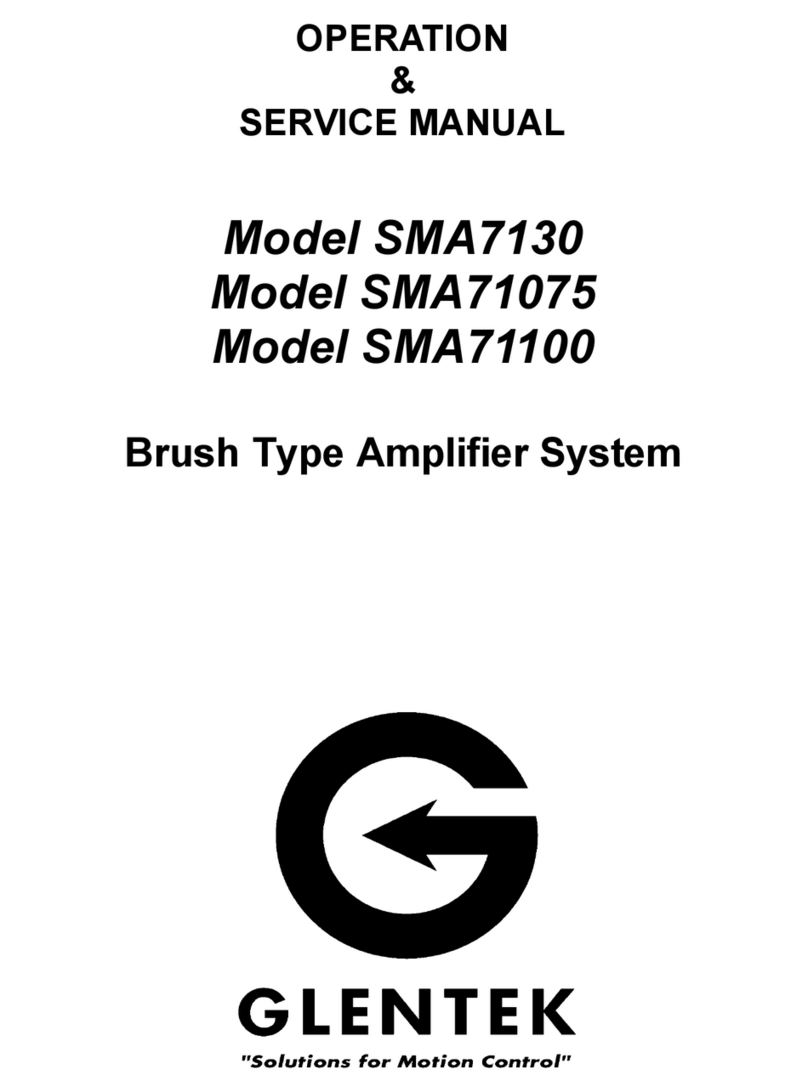
Glentek
Glentek SMA7130 Installation and operating instructions
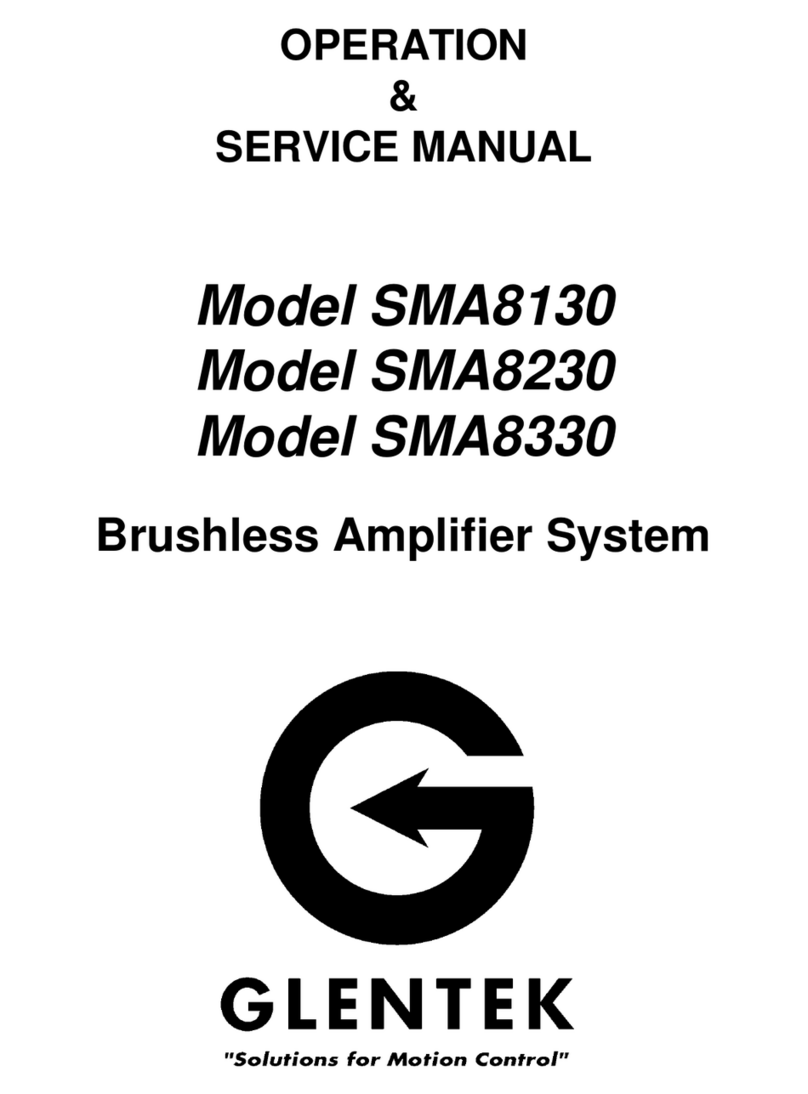
Glentek
Glentek SMA8130 Installation and operating instructions
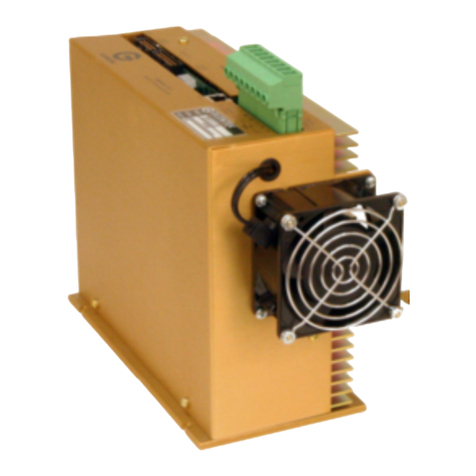
Glentek
Glentek Alpha Series User manual
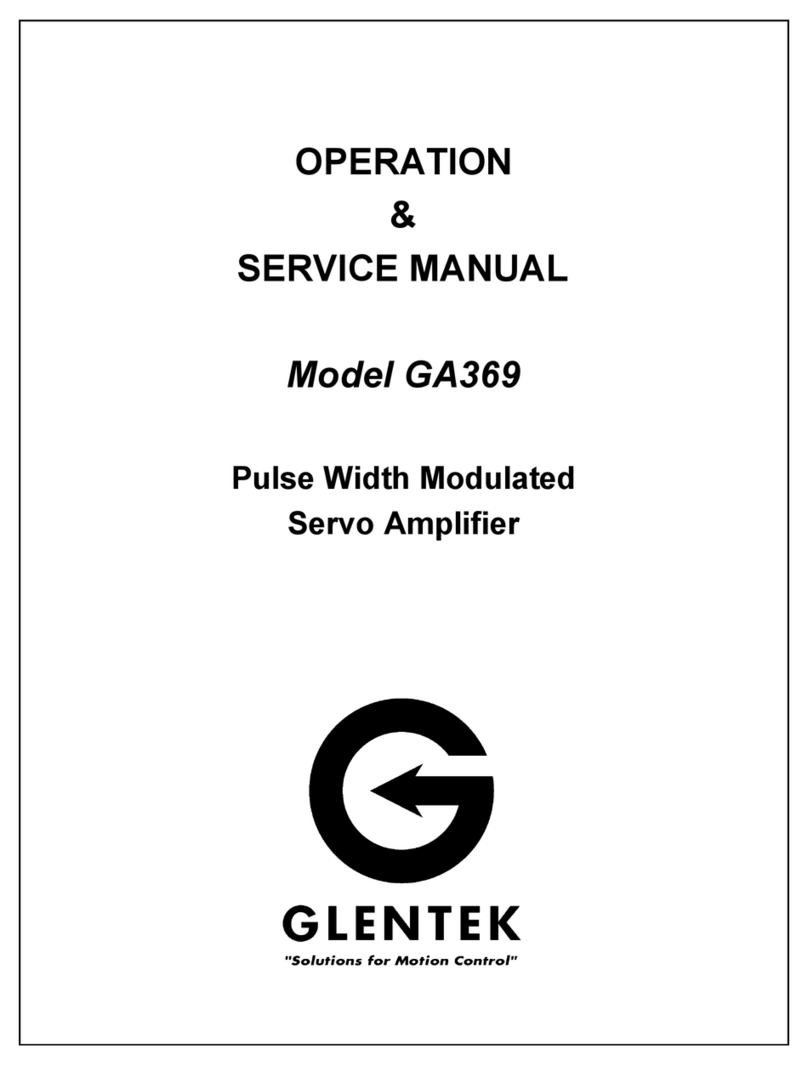
Glentek
Glentek GA369 Installation and operating instructions
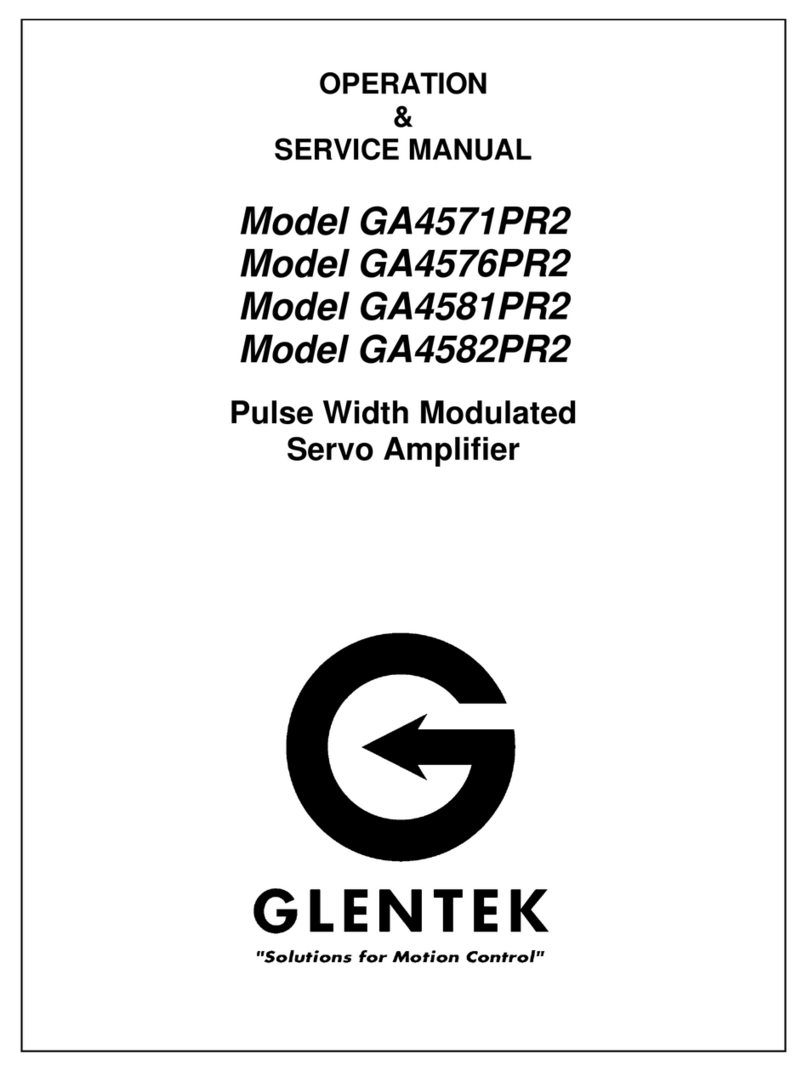
Glentek
Glentek GA4571PR2 Installation and operating instructions

Glentek
Glentek SMA8730 Installation and operating instructions
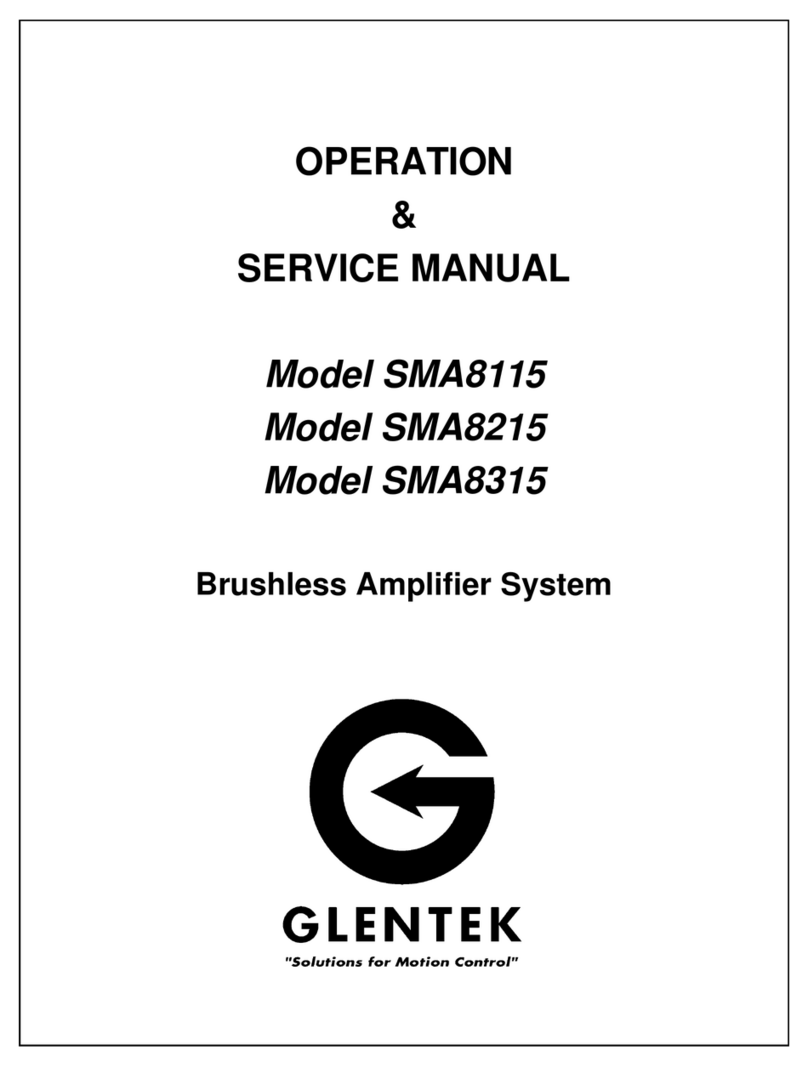
Glentek
Glentek SMA8115 Installation and operating instructions
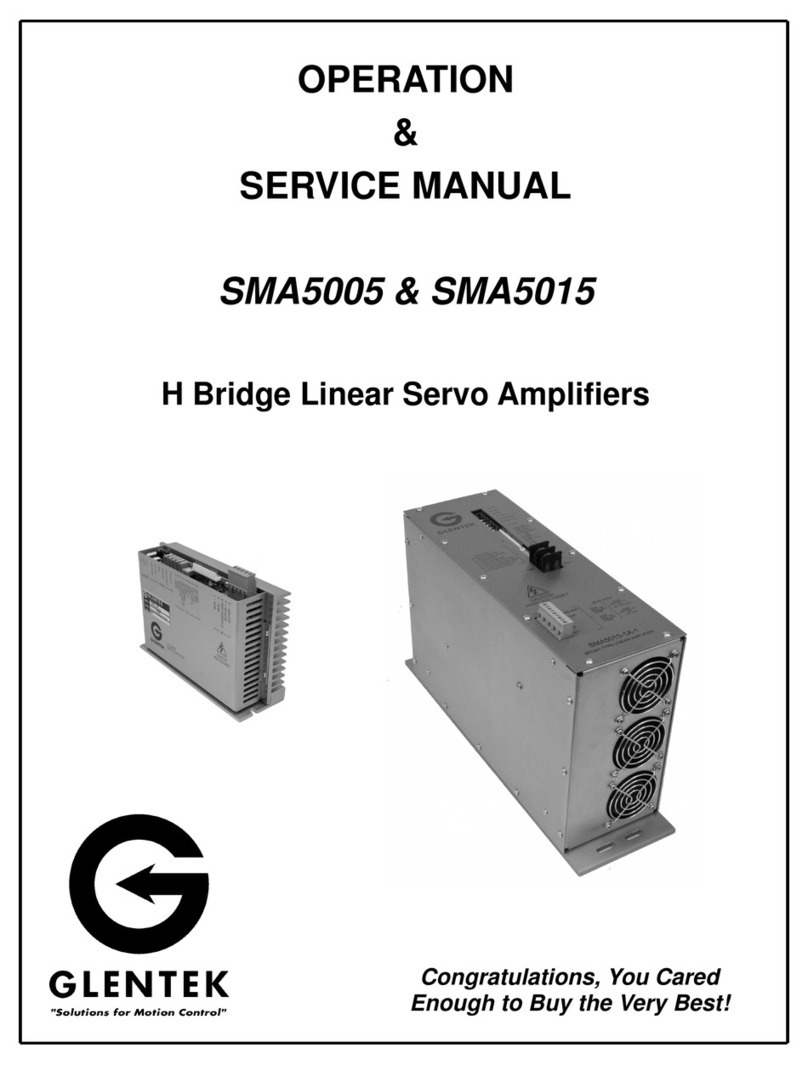
Glentek
Glentek SMA5005 Installation and operating instructions
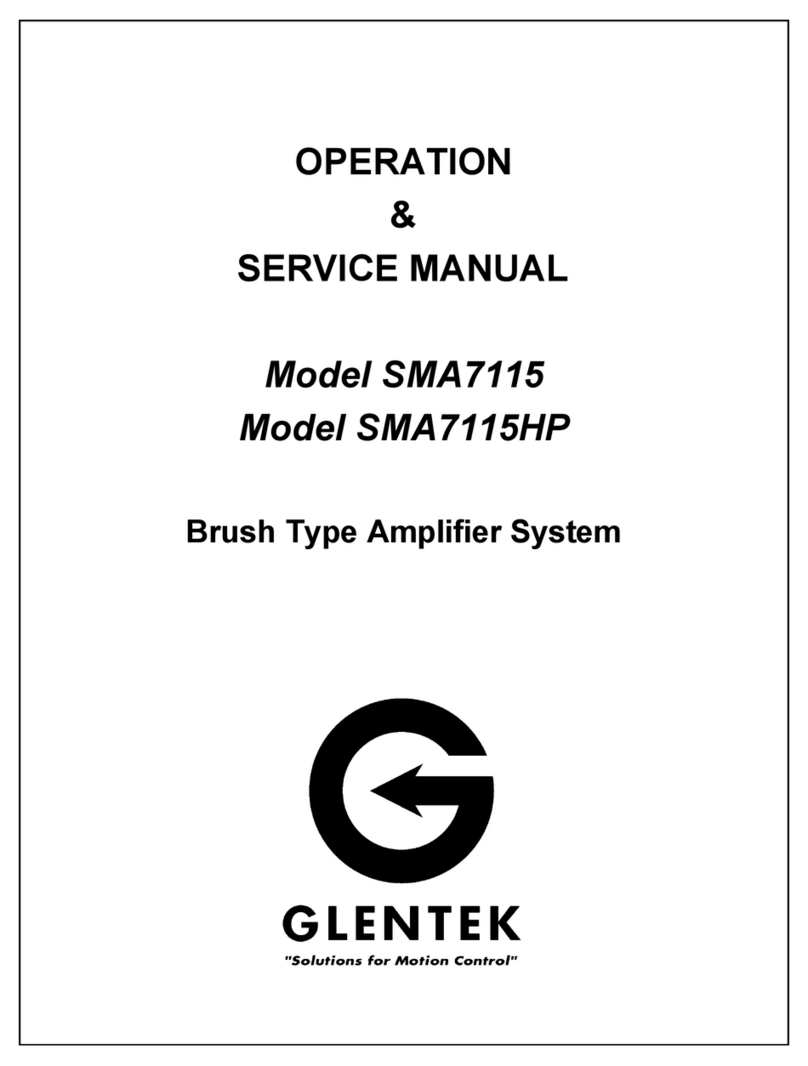
Glentek
Glentek SMA7115HP Installation and operating instructions
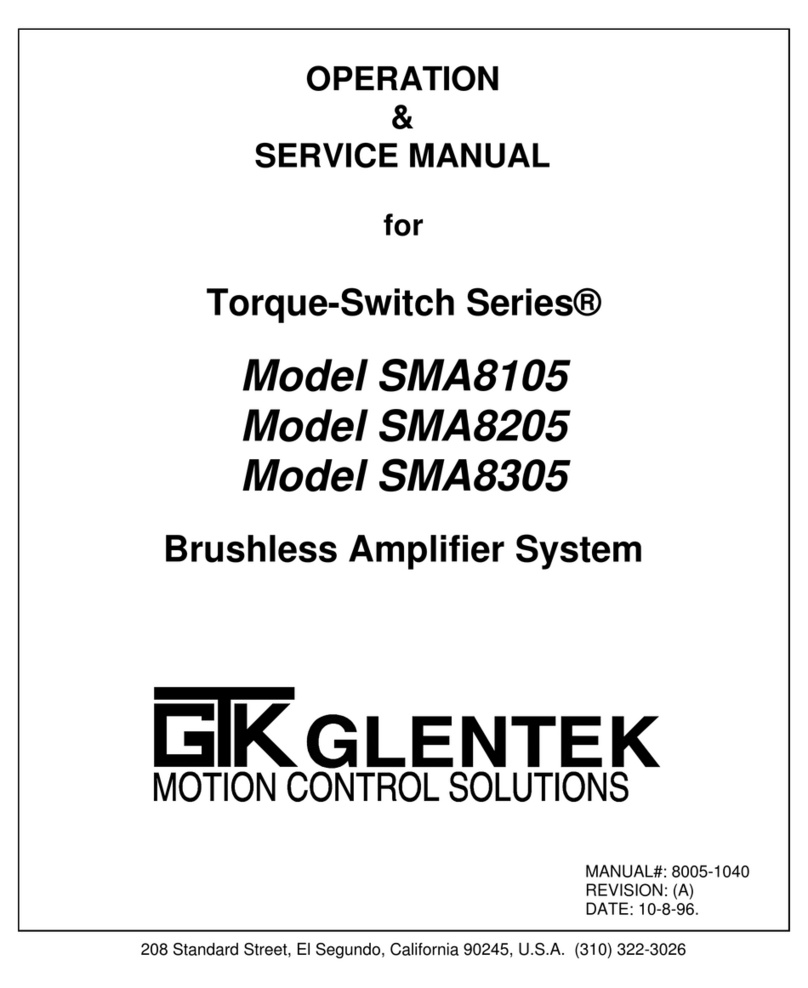
Glentek
Glentek SMA8105 Installation and operating instructions

